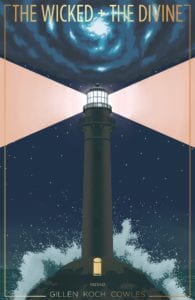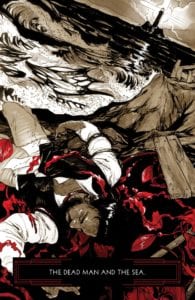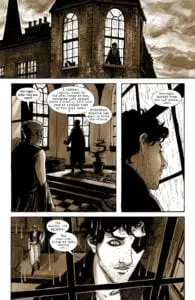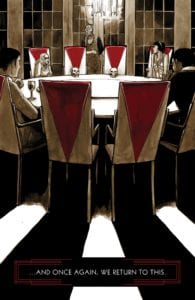“Every ninety years twelve Gods return as young people. They are loved. They are hated. In two years, they are all dead. ” It is with these words that we gleefully plunge back into the bloody and charming world of The Wicked and The Divine. If you’re acquainted with my reviews of this comic, you’ll know I tend to inexhaustibly heap praise upon it. And there’s a good reason for that – this comic has it all: an engaging narrative, a beautiful style, great characters, and all the whimsical little graces manifested into plot twists, sex, and death.

But if you also have an eye for intertextuality, particularly of mythological type, you’ll inevitably find a real treasure in WicDiv. Moments that reward the knowing by retelling, deconstructing and subverting the narratives of the Gods. By now, you must be figuring out that I’m referring to the whole of the comic rather than a more specific approach on this special, which – by the title alone – we know to be the most immediate prequel to the main run. It’s not that I find little to say about it (quite the contrary), but the approach to this review will be quite different.
As opposed to my usual reviews, I cannot bring myself to comment in great detail on the events themselves. Really, if you’ve ever read anything by the Master-of-Suspense, Agatha Christie, or played Clue, you got this story right there. Plain and simple; a murder-mystery that we’re to solve. And by now, we already know Gods are supposed to die, mostly by Ananke’s doing. So what can we actually say on this special? What is it that turns this take on the second-to-most-recent Recurrence, a work of genius?
The answer: everything else. Especially if you’re an English major… which I am, by the way. Imagine a gravelly squee on my part, and let’s dig in.
1923AD
“This will have to be my Masterpiece”
The first thing to note here is the actual form of the comic. And even the word comic feels pretty weird in my tongue when talking about this special. In fact, I would rather talk about 1923AD as an illustrated novella. Think Neil Gaiman’s Stardust, illustrated by Charles Vess: a work consisting of descriptive prose with pictures as interludes. This delivery alone means the narrative leans more on the writer’s shoulders, rather than the usual collaborative equilibrium between Kieron and Jamie. For this reason, 1923AD exhibits the finest of Kieron Gillen’s writing, which should say aplenty on its own.
Not only does he colour his descriptive prose with the appropriate style, but he also applies some high-brow wit to pour a little humour and subversion into an otherwise pretty bleak story.

But what about the graphical portion? As always, Jamie McKelvie and Matt Wilson have the cover… eh, covered. The image is that of an ominous-looking lighthouse with a most peculiar light in the nightly sky above. Simple, yet powerful. But as for the rest of the issue, it’s Aud Koch who graces the illustrations with her pencils, famously rich in erotism and semiotics, though applied slightly more conservatively here, still far from austere – must be said. Her palette is mostly just three hues; the whites and blacks that allow for impactful contrasts and light management, and of course, the reds that inextricably seal the tone.
All in all, her role in this issue is to portray the immediate aftermath of each murder, as well as the tastier, fleshier bits of drama between the Gods. And if we’ve learned anything so far – there is a lot of drama to be had. Lovely.
Of course, the black and white ambiance also functions to set the story in a timeframe, that of the twenties, a decade we all know by pop-culture-osmosis with very distinctive aesthetics. We usually think jazz, flappers, some dapper debauchery. But we’re not talking about that kind of twenties, at least not dominantly. Sure, the style is alluring, but the creative zeitgeist going alongside the partying is a whole world of its own – and we know it as Modernism. I’ll try to keep my fanboy-ism about this artistic period on a leash here.
And then, there were twelve…
This is where art started to reject the cold, unfeeling paradigm of the Enlightenment and old narratives were given new life through new perspectives and towards new orientations. Hence, characters that were without a voice now boomed out loud, and the Classic aesthetics looked a tad less idyllic. One could say that WicDiv, as a retelling and challenging of the old conventions surrounding the Gods’ stories is a strongly modernist exercise. The relation between creative impulse and divinity certainly imbued the so-called “Lost Generation” with a mystique purely of their own.
So it should be no surprise that this Pantheon, much as the one from 1831, takes heavy inspiration from contemporary artists. Herein lies another bit of genius, or research (or both) on Kieron’s part. It takes solid knowledge of these real-life personages’ work, reputation, demeanour, even political stance to properly ‘reincarnate’ them into Gods. And though there is some room to question or to propose a better fit, I personally found it flawless. Cue another squee at realising that the author or my favourite poem (not necessarily my favourite poet), The Waste Land, made the cut.

The casting to this mystery is as follows: T.S. Eliot as Baal. F. Scott Fitzgerald as Lucifer (as if there possibly any better fit than this). James Joyce as The Morrigan. Ernest Hemingway as Neptune. A trio of H.G. Wells, Aldous Huxley, and George Orwell as The Norns. Virginia Woolf as Set. Joseph Goebbels as Woden (token shithead for a God). Pablo Picasso as Dionysus. Clara Bow as Amaterasu. Buster Keaton as Susanoo. Langston Hughes as Amon Ra. And Shirley Temple as Minerva. The last four we already know from the very beginning of WicDiv’s first issue. And we may as well include Agatha Christie herself as Ananke, being the one who constructs the scenario for her God-killing ways.
The accuracy of selection is one thing. But a character is more than their name – a character is also their deeds and delivery. So the link between artist and God also outlines their role in this fashion. Therefore one can dare a guess at what each will do based on what we know of the personage and the God. It only makes sense that the futurist folks would play the fates who behold the truth and the future. It feels natural that there be a divide between the God-Artists leading the vanguard in medium and style, and the more conservative, academia-oriented folks. And above all, it makes perfect sense that of all the characters, The Morrigan’s speech bubbles are DELIGHTFUL.
I channel my inner Broken/Woken Matt Hardy every time I use caps, you know.
Your times are ending
Feels great to rejoice over the usage and selection of characters. But that’s not all there is to the special. The plot itself is rewarding by its tone and content. As I previously said, the plot is succinct enough. It’s an Agatha Christie novel, And then there were none, to be specific: a private feast for the Gods in an island on their final days. But there are some certainties we have as soon as we open the first page. First, judging by WicDiv‘s very first page, the readers know that the last remaining Gods in this Recurrence are Minerva, Susanoo, Amaterasu and Amon Ra. They all agree to commit suicide at Ananke’s (we know now dubious) advise. And the fact that all the rest are alive and well at the start of 1923AD means they will be killed off, one by one.

As a gesture of love and respect to Agatha, and faithfulness to the genre, I won’t go into details about who dies when and how (the ‘how’ being the most fascinating thing up the author’s literary sleeve). I also won’t spoil the inevitable inner drama unfolding amidst the Gods. But I will indeed observe how 1923AD fits alongside 1831 and 455 AD in one very special regard: the revealing of vital knowledge irretrievable to the current 21’st Century Pantheon. Well, sort of – we still don’t know what’s up with Minerva-Ananke. But I digress.
This time, we get a hint on the origin of the Great Darkness, the implications of which are highly disturbing. Since it is only a hint, we can only cast conjectures; but each one inevitably affects the whole of the narrative as we put the pieces together. But although we have the methodical knowledge of how the chain of murders unfolded, the special shatters the ambiance by taking us to the present by preserving one mystery still: Ananke’s long-term goal. What is she trying to accomplish through her deceptive, bloody means? And again, what’s up with them talking heads at the end of the last issue?
And with that uncertainty, we’ll be more than aching to get our hands on next issue – the next arc. Stay tuned, lovelies – and above all, get your hands on this beauty.
The Wicked + The Divine 1923AD Credits
Writer: Kieron Gillen
Artist: Aud Koch
Cover: Jamie McKelvie, Matt Wilson
Letterer: Clayton Cowles

